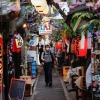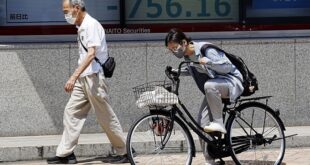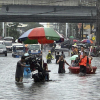Hanoi can only go ahead with its plan to ban motorbikes by 2025 if it can rapidly create infrastructure for public transport, experts have said.
The Hanoi People’s Committee plans to reduce congestion by banning motorcycles in core districts in 2025, five years earlier than according to a previous plan announced in 2019.
The city of eight million people now has 6.4 million vehicles, including 5.6 million motorbikes.
Phan Le Binh, a traffic planner, said Hanoi should consider if its public transport infrastructure could hold up to the challenge in four years’ time.
The recently opened Cat Linh-Ha Dong metro service, along with the proposed Nhon-Hanoi Railway Station route, would each be able to meet 5-7 percent of travel demand in the city, he said.
But the eastern and northern areas still lack the capability to satisfy demand, he pointed out.
He recommended limiting personal vehicles, and only ban them on routes where public transport is adequate.
“It means there must be designated areas to limit or ban motorbikes, instead of having a carpet ban in entire districts. Only when public transport can meet 60-70 percent of travel needs should Hanoi ban personal vehicles.”
The city should speed up its metro projects and encourage people to use them, he said.
“In the next seven or eight years the city should have two or three more metro lines before banning motorbikes. That means starting in 2030.”
Banning motorbikes when public transport is inadequate could cause people to switch to cars, he warned.
He cited the example of Myanmar’s Yangon where a motorbike ban caused the number of personal cars to skyrocket, worsening traffic jams in the city.
“Car prices are going down, meaning people will buy them more, but a car takes up five times the space of a motorbike. There is also no guarantee that banning motorbikes will help relieve traffic congestion.”
Nguyen Van Quyen, head of the Vietnam Automobile Transport Association, said: “Hanoi should provide a solution to convince people to switch vehicles. That is the issue to be debated about, not just a motorbike ban.”
The capital should diversify its public transport vehicles, for instance using smaller buses in narrow streets, encourage people to walk and cycle by providing bike lanes and maintain sidewalks well to making walking a convenient option, he said.
Bui Danh Lien, deputy head of the Vietnam Automobile Transport Association, said the proposal to ban motorbikes from 2025 is “difficult to achieve” due to the lack of infrastructure.
“The Cat Linh-Ha Dong metro line and the BRT are not well connected.”
The city should survey the public about the motorbike ban, he added.
The plan envisages banning motorbikes in all districts through which the third ring road passes and on three major roads: Truong Sa, Hoang Sa and National Highway 5.
After 2030 the ban will be expanded to all districts within the fourth ring road.
- Reduce Hair Loss with PURA D’OR Gold Label Shampoo
- Castor Oil Has Made a “Huge” Difference With Hair and Brow Growth
- Excessive hair loss in men: Signs of illness that cannot be subjective
- Dịch Vụ SEO Website ở Los Angeles, CA: đưa trang web doanh nghiệp bạn lên top Google
- Nails Salon Sierra Madre
 VnExpress News The News Gateway of Vietnam
VnExpress News The News Gateway of Vietnam





